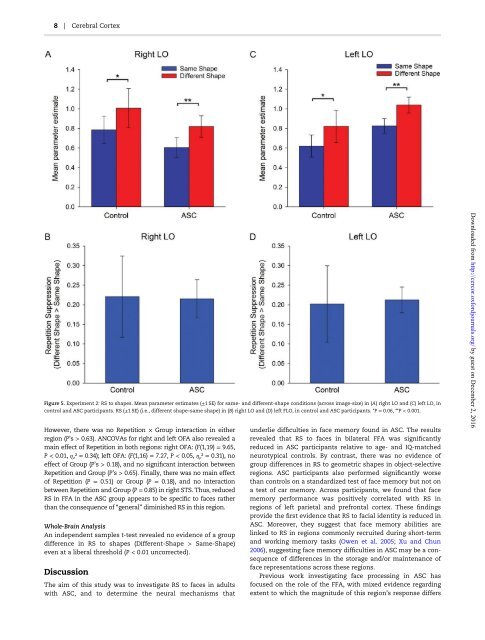http://cercor.oxfordjournals.org/
zeppjbn
zeppjbn
You also want an ePaper? Increase the reach of your titles
YUMPU automatically turns print PDFs into web optimized ePapers that Google loves.
8 | Cerebral Cortex<br />
Figure 5. Experiment 2: RS to shapes. Mean parameter estimates (±1 SE) for same- and different-shape conditions (across image-size) in (A) right LO and (C) left LO, in<br />
control and ASC participants. RS (±1 SE) (i.e., different shape–same shape) in (B) right LO and (D) left FLO, in control and ASC participants. *P = 0.06, **P < 0.001.<br />
However, there was no Repetition × Group interaction in either<br />
region (P’s > 0.63). ANCOVAs for right and left OFA also revealed a<br />
main effect of Repetition in both regions: right OFA: (F(1,19) = 9.65,<br />
P < 0.01, η ρ ² = 0.34); left OFA: (F(1,16) = 7.27, P < 0.05, η ρ ² = 0.31), no<br />
effect of Group (P’s > 0.18), and no significant interaction between<br />
Repetition and Group (P’s > 0.65). Finally, there was no main effect<br />
of Repetition (P = 0.51) or Group (P = 0.18), and no interaction<br />
between Repetition and Group (P = 0.85) in right STS. Thus, reduced<br />
RS in FFA in the ASC group appears to be specific to faces rather<br />
than the consequence of “general” diminished RS in this region.<br />
Whole-Brain Analysis<br />
An independent samples t-test revealed no evidence of a group<br />
difference in RS to shapes (Different-Shape > Same-Shape)<br />
even at a liberal threshold (P < 0.01 uncorrected).<br />
Discussion<br />
The aim of this study was to investigate RS to faces in adults<br />
with ASC, and to determine the neural mechanisms that<br />
underlie difficulties in face memory found in ASC. The results<br />
revealed that RS to faces in bilateral FFA was significantly<br />
reduced in ASC participants relative to age- and IQ-matched<br />
neurotypical controls. By contrast, there was no evidence of<br />
group differences in RS to geometric shapes in object-selective<br />
regions. ASC participants also performed significantly worse<br />
than controls on a standardized test of face memory but not on<br />
a test of car memory. Across participants, we found that face<br />
memory performance was positively correlated with RS in<br />
regions of left parietal and prefrontal cortex. These findings<br />
provide the first evidence that RS to facial identity is reduced in<br />
ASC. Moreover, they suggest that face memory abilities are<br />
linked to RS in regions commonly recruited during short-term<br />
and working memory tasks (Owen et al. 2005; Xu and Chun<br />
2006), suggesting face memory difficulties in ASC may be a consequence<br />
of differences in the storage and/or maintenance of<br />
face representations across these regions.<br />
Previous work investigating face processing in ASC has<br />
focused on the role of the FFA, with mixed evidence regarding<br />
extent to which the magnitude of this region’s response differs<br />
Downloaded from <strong>http</strong>://<strong>cercor</strong>.<strong>oxfordjournals</strong>.<strong>org</strong>/ by guest on December 2, 2016


